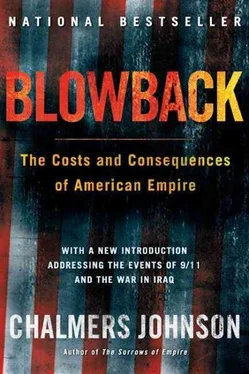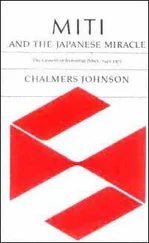Chalmers Johnson - Blowback, Second Edition - The Costs and Consequences of American Empire
Здесь есть возможность читать онлайн «Chalmers Johnson - Blowback, Second Edition - The Costs and Consequences of American Empire» весь текст электронной книги совершенно бесплатно (целиком полную версию без сокращений). В некоторых случаях можно слушать аудио, скачать через торрент в формате fb2 и присутствует краткое содержание. Год выпуска: 0101, ISBN: 0101, Издательство: Macmillan, Жанр: Старинная литература, на английском языке. Описание произведения, (предисловие) а так же отзывы посетителей доступны на портале библиотеки ЛибКат.
- Название:Blowback, Second Edition: The Costs and Consequences of American Empire
- Автор:
- Издательство:Macmillan
- Жанр:
- Год:0101
- ISBN:9780805075595
- Рейтинг книги:5 / 5. Голосов: 1
-
Избранное:Добавить в избранное
- Отзывы:
-
Ваша оценка:
- 100
- 1
- 2
- 3
- 4
- 5
Blowback, Second Edition: The Costs and Consequences of American Empire: краткое содержание, описание и аннотация
Предлагаем к чтению аннотацию, описание, краткое содержание или предисловие (зависит от того, что написал сам автор книги «Blowback, Second Edition: The Costs and Consequences of American Empire»). Если вы не нашли необходимую информацию о книге — напишите в комментариях, мы постараемся отыскать её.
Blowback, Second Edition: The Costs and Consequences of American Empire — читать онлайн бесплатно полную книгу (весь текст) целиком
Ниже представлен текст книги, разбитый по страницам. Система сохранения места последней прочитанной страницы, позволяет с удобством читать онлайн бесплатно книгу «Blowback, Second Edition: The Costs and Consequences of American Empire», без необходимости каждый раз заново искать на чём Вы остановились. Поставьте закладку, и сможете в любой момент перейти на страницу, на которой закончили чтение.
Интервал:
Закладка:
Even if they avoid being raped or run down, no Okinawans can escape the endless noise the Americans make. A teacher in Ginowan City typically reports, “My class lasts for fifty minutes. It is interrupted at least three times by the incredible noise of planes landing and departing. My students cannot hear me, so we just wait patiently.” 18There are 52,000 takeoffs and landings each year at Futenma Marine Corps Air Station alone, or 142 a day. The military airfield is in the center of and entirely surrounded by Ginowan’s neighborhoods. The middle of a densely populated city is hardly an appropriate place to locate an airport, let alone a military one, and genuinely thoughtful neighbors would have moved it long ago. Even the marines know this. In March 1997, the corps grounded its helicopters for a day just so the students of Ginowan’s high schools could take their college entrance exams in peace. “ ‘Not in my backyard’ politics have motivated Okinawans for a long time,” asserts Joseph Nye, a Harvard political scientist and former assistant secretary of defense for international security affairs whom the Pentagon employed to study potential new “threats” to national security that might justify its expensive presence in other people’s countries. 19But Nye, while suggesting the United States keep one hundred thousand troops in Japan and South Korea until at least the year 2015, like so many American officials and policy advisers, never once visited Okinawa to see what that “backyard” was really like.
While the major cause of noise pollution in Okinawa is military aircraft, there are some other unusual sources. From 1973 to 1997, the 12th Marine Regiment passed its time in Okinawa by periodically firing 155 mm. howitzer shells over Highway 104 where it enters Kin village (which also happens to be where the rape took place). Every time the marines decided to fire their guns, the highway had to be closed. In 1993, for example, the marines poured 5,606 rounds into Mount Onna on the other side of the highway, causing great environmental damage, including repeated forest fires. Unsurprisingly, they also left numerous unexploded shells on its gently inclined slopes. Requests to stop lest the tourist industry, which is by far Okinawa’s most important current source of income, be damaged were simply ignored.
Only after the rape did the local marine commander suspend the firing for three months, as a gesture of contrition. In response to continuing protests, the Japanese government finally found mainland sites for marine artillery practice. In so doing, it allocated ¥238 million to help relocate mainland families likely to be disturbed by one of the new firing ranges near Sendai in Miyagi Prefecture, which led the mayor of Kin to ask bitterly, “If the government can provide such compensation on the mainland, why the hell not in Okinawa?” 20
Noise-pollution suits are starting to prove expensive for the Japanese government. In 1982, some 906 residents of Kadena and Chatan villages filed a noise-pollution suit against Kadena Air Force Base and asked the court to halt night flights. Sixteen years later the Naha branch of the Fukuoka High Court ordered the central government to pay compensation of ¥1,373 million to those plaintiffs still alive. The court did not, however, order a suspension of flights between seven P.M. and seven A.M., on the grounds that nothing in the security treaty or in domestic law allows Japan to interfere with the operations at Kadena Air Force Base. The U.S. military likes to say that the noise from its aircraft is the “sound of freedom,” but many Okinawans have been so deafened that they can no longer hear it.
Closely related to noise pollution is damage to the environment. This includes serious soil erosion from artillery firing and damage to coral reefs by ships and amphibious landing practice (despite a U.S. commitment to an international initiative to save the globe’s dying coral reefs). Runoff jet fuel and other toxic substances permeate the soil and water supplies in certain areas of the island and have generally neither been controlled nor cleaned up. As the U.S. Congress’s General Accounting Office reported in 1998, “Marine Corps Bases, Japan, and other Okinawa-based U.S. forces were informed by a letter dated August 25, 1997, from the Government of Japan’s Naha Defense Facilities Administration Bureau that the toxic substances mercury and polychlorinated biphenyls were found on the Onna communications site. The United States had closed the base and returned the land to Japan in November 1995. . . . The letter indicated that the presence of these substances has prevented the land from being returned to its owners and thus being available for reuse. The letter concludes by requesting that the United States conduct a survey, identify any contamination that may exist, and clean up bases scheduled for closure in the future.” 21The government, while proclaiming itself devoted to protecting the environment, has also claimed that the security treaty explicitly exempts the United States from any responsibility for environmental cleanup.
The most spectacular documented environmental outrage to date has been a barrage of some 1,520 “depleted uranium” shells fired in December 1995 and January 1996 into Torishima Island, located about a hundred kilometers west of the main island of Okinawa. These 25 mm. armor-piercing shells, each of which contained 147 grams of uranium, were first used by the United States in the Gulf War. It is suspected that the uranium oxide produced when this kind of projectile hits its target (along with other gases released when the Americans demolished Saddam Hussein’s armories) may have been a cause of so-called Gulf War syndrome. 22For over a year the Americans failed to inform Japanese officials about this open violation of Pentagon regulations specifying that such ammunition should be used only at specific firing ranges on the U.S. mainland. No one, in fact, would ever have known, had the Washington Times not broken the story. 23Clearly fearing its culpability, however, the military had already sent troops into Torishima in March and April 1996 but had recovered only 192 of the shells.
The use of any weapon laced with uranium in any capacity in the only nation on earth to have experienced atomic warfare firsthand—and especially given that the “hands” that destroyed Hiroshima and Nagasaki were American—was hardly likely to engender good publicity, to say the least. When the story broke, in fact, a deeply embarrassed Prime Minister Hashimoto had to reveal that he had learned about the depleted uranium shells still on Torishima from the Americans (who undoubtedly knew that the story would soon break) and had done nothing. When the unauthorized use of such ammunition in Okinawa was exposed, the assistant secretary of defense for public affairs assured the media, “There is no danger to the human body or to the environment. The level of radiation [emitted by depleted uranium bullets] is just about half that of a TV set in the 1950s.” 24But a TV set emits ultraviolet rays, not gamma or X-rays, and ultraviolet rays do not cause cancer—as the Japanese media were quick to point out. Depleted uranium bullets, on the other hand, gasify into uranium oxide upon hitting a target, such as a tank or the ground. This gas is then carried as particles in the air or dust into the lungs, bloodstream, kidneys, and bone marrow, leading to possible leukemia and tumors.
Each mini-crisis like this is in itself a mini-example of blowback, as American imperial policies and attitudes, long established, manifest themselves in particular incidents. Each of these further undermines not only long-term American policy in Asia but, far more important, long-term attitudes of the Japanese toward Americans in general. The Americans have a record of degrading some of the most exquisite subtropical terrain in the Pacific and also of depriving the Okinawan people of the livelihoods they might have reasonably expected if the bases were not located in their midst. It is a common bit of American folklore that such bases are valuable to local economies, whose peoples have vested interests in them. In the case of Okinawa, this could not be further from the truth. Its major industry today is tourism. The presence of so many sprawling, disconnected American installations, as well as over fifty thousand Americans who do not pay taxes and have no stake in Okinawa’s future, does nothing to enhance the islands’ attraction to Japanese and Taiwanese tourists.
Читать дальшеИнтервал:
Закладка:
Похожие книги на «Blowback, Second Edition: The Costs and Consequences of American Empire»
Представляем Вашему вниманию похожие книги на «Blowback, Second Edition: The Costs and Consequences of American Empire» списком для выбора. Мы отобрали схожую по названию и смыслу литературу в надежде предоставить читателям больше вариантов отыскать новые, интересные, ещё непрочитанные произведения.
Обсуждение, отзывы о книге «Blowback, Second Edition: The Costs and Consequences of American Empire» и просто собственные мнения читателей. Оставьте ваши комментарии, напишите, что Вы думаете о произведении, его смысле или главных героях. Укажите что конкретно понравилось, а что нет, и почему Вы так считаете.










